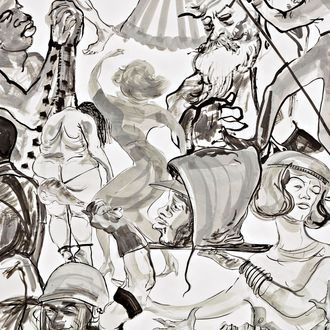
James Baldwin once said that “no true account really of black life can be held, can be contained, in the American vocabulary.” Kara Walker’s devastating new exhibition suggests that such an account might be given visibly. Or at least that Walker is coming close. Witness her mad Boschian American Babylon of race, irredeemable evil, barbarity, hatred, demons, white people self-cretinizing, lynchings, dominance, submission, rage, modern Black Power figures, shuffling black cleaning ladies, beneficent whites, Civil War soldiers, plantation owners drawn and quartered by rebellious slaves, pickaninnies and Sambos sexually servicing white masters or being castrated. Taken together, this show is as terrifyingly beautiful as Goya’s masterpiece of Saturn devouring his children, a shadow of something as dark and mysterious as Melville’s Pequod.
It is not, and should not be, a surprise that Walker has achieved something this monstrously magnificent. I’ve written on Walker since 1994, the year I was thunderstruck when I saw her student work at RISD — a drawing, rendered in chocolate, of a “white” child trying to wash the color off a “black” child. Immediately, I saw a coming avenging angel. Beginning with the cut-paper silhouette mural she exhibited at the Drawing Center that same year, which also focused on historical brutality and ugliness, Walker has been exactly that. And has also been attacked by established artists of color who said — and still say! — she’d gone too far, making artworks they felt were a disservice to their political cause. Since then, she’s only gotten better, braver, stronger, more skilled, fearless.
The name of her show is written in barker banter. (Walker is tremendous with language.) It reads, in part: “Collectors of Fine Art will Flock to see the latest Kara Walker offerings, and what is she offering but the Finest Selection of artworks by an African-American Living Woman Artist this side of the Mississippi.” It continues: “Students of Color will eye her work suspiciously and exercise their free right to Culturally Annihilate her on social media. Parents will cover the eyes of innocent children … The Final President of the United States will visibly wince. Empires will fall …” An accompanying artist’s statement, meanwhile, reads as a manifesto for many artists of color: “I am tired, tired of standing up, being counted, tired of ‘having a voice’ or worse ‘being a role model.’ Tired, true, of being a featured member of my racial group and/or my gender niche. It’s too much … my capacity to live in this Godforsaken country as a (proudly) raced and (urgently) gendered person is under threat by random groups of white (male) supremacist goons who flaunt a kind of patched together notion of race purity with flags and torches and impressive displays of perpetrator-as-victim sociopathy.” It concludes: “… in how many ways will the racists among our countrymen act out their Turner Diaries race war fantasy combination Nazi Germany and Antebellum South — states which, incidentally, lost the wars they started, and always will, precisely because there is no way those white racisms can survive the earth.” We’re optical geographers in Walker’s grotesque phantasmagorical landscape of American racial dreams — a United Failed States of America. Walker is reclaiming her name, essentially saying, I am an artist — not a “black artist” — who is sick and tired of the long American night of racism and will now use my art as a weapon of mass destruction to attack it head-on.
In addition to a number of smaller paintings, the show contains two large poisonous masterpieces, The Pool Party of Sardanapalus (After Delacroix, Kienholz) and U.S.A. Idioms. These are done in a process new to Walker but so drop-dead obvious it’s extraordinary she didn’t hit on it sooner (to solve problems that arise when compositions get large and can’t be changed). It also stops her surfaces from dying a little. She deploys cutout images drawn in sumi ink onto giant white sheets of paper by blowing up her drawings, which allows her to move them around her giant compositions (rather than never being able to change a single part without affecting the whole). This points to whole new possibilities of scale, surface, and spatial organization, and even to the raising of drawing to the level of history painting and to Walker’s doing with collage and drawing what she did so well with silhouette. Included in these two audacious works are images of slave children seeking rescue from a tree topped by a Confederate banner, slaves burying dead soldiers, and an urban gangster knifing a shirtless black man as a white man tries to restrain him. Finally, a black woman (Walker?) sticks a knife or pen into the bloated belly of a fat, hands-up, naked Donald Trump. It’s extraordinary to see an artist responding so well to the incredible political storm blowing all around us. I am told that these giants have been done in the last few months.
Another work, however, rises above these two standouts. Along with Walker’s gigantic 2014 sugarcoated sphinx Aunt Jemima, it is perhaps the greatest work about America made in the 21st century. The title of the painting is Christ’s Entry into Journalism. It should be installed permanently next to the Met’s Washington Crossing the Delaware as a post–Civil War/contemporary counterbalance. It is as big as a barge, an inchoate Sadean vision of almost 100 figures drawn in Walker’s signature Brueghel-Daumier-Goya-Ensor way.
The work echoes James Ensor’s gigantic 1888 masterpiece Christ’s Entry into Brussels in 1889. In it, Walker depicts an uncentered mystic mountain of murder, pillage, carpetbaggers, lumpen golems, and historical figures including Trayvon Martin’s hoodie-clad head presented on a platter borne by a white lady (maybe an allegorical figure of Justice) surrounded by a Batman fleeing with a mummy-wrapped Uncle Ben–like man while a black church lady begs for the boy’s body.
Elsewhere in the composition, a black man is clubbed by a white policeman in riot gear who videos it on his iPhone. Walker is out for blood. An explorer applies calipers to the naked ass of Sarah Baartman (1789–1815), who was taken into captivity in Africa, brought to Europe, and humiliated before throngs as the “Hottentot Venus.” A process-haired James Brown belts into a microphone, marchers with protest signs march, a naked Mandingo with an enormous penis performs cunnilingus on a screaming naked black woman as a white church lady strikes him with her umbrella. At the bottom right is Martin Luther King. Lest you think you are projecting identities onto these figures, near the top are two birdman figures or Klansmen. One has a thought balloon that reads OBVIOUSLY WE’RE CONTEMPORARY REFERENCES.
This brings us to the crescendo of this empire-destroying machine. At the bottom, a Black Panther–like figure stands beside a Frederick Douglass look-alike. He gives the Black Power salute and holds aloft by the hair the severed head of Donald Trump. On its forehead is a penciled-in swastika. You just sense this brand was placed post-Charlottesville. Finally, at the top of this pile, a corpulent, double-hooded Klansman stands between the two birdmen. From beneath the legs of this KKK member, an impish personage lifts robes and sticks his tongue out at us while excreting. And there he is again, Donald Trump. Nearby, two swinging black girls perform trapeze from a branch with a lynched body hanging from it. The scene encapsulates Walker’s lethal ability to mix the historical grotesque with carnivalesque madness in ways that horrify and accuse, sparing no one—and that keeps us forever afire in a volcanic vent of psychic perdition. It will be a crime if this work doesn’t end up on permanent display in a prominent New York museum.
“The most Astounding and Important Painting show…” is at Sikkema Jenkins & Co. through October 14.
*This article appears in the September 4, 2017, issue of New York Magazine.




